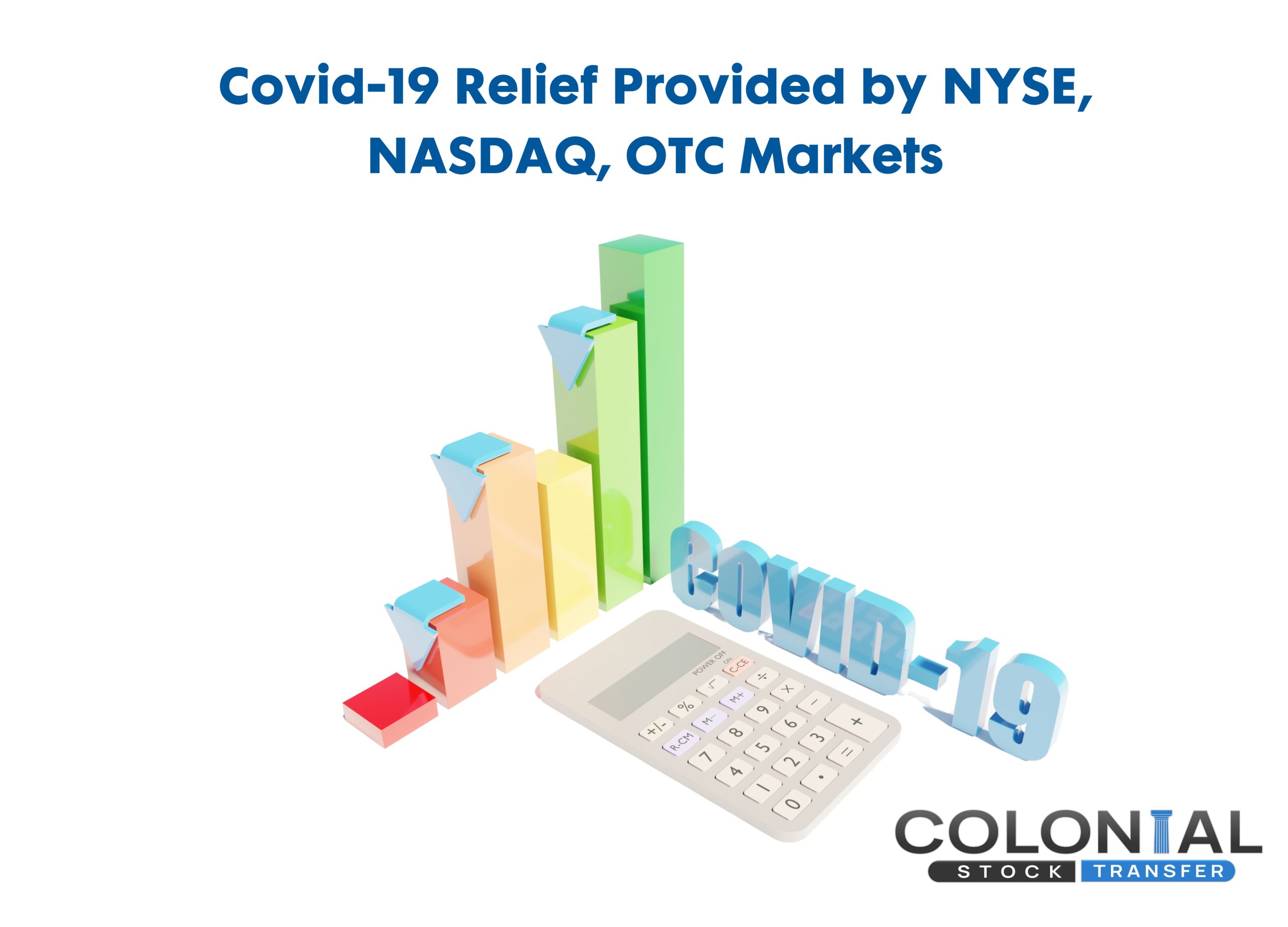
Recently, due to COVID-19, exchange listed companies have been struggling to comply with rules set forth for timely administration of annual shareholder meetings and SEC filings. Considering these situations and the fact that many listed companies are facing the risk of not meeting the continued listing standards, the SEC and exchanges, including the NASDAQ, NYSE and OTC Markets continue to provide relief. Given below is a description of how these markets have responded to the crisis:
NYSE:
NYSE formally announced rule changes to continued listing Market Cap and Shareholder Approval requirements in March and April after receiving approval from the SEC. It is the second time after 2009 that the NYSE has suspended specific continued listing standards.
- Global Market Capitalization: Rule 802.01B of NYSE requires companies to maintain a market capitalization of at least $15 million over a period of 30 consecutive trading days. NYSE provided a grace period extending through June 30, 2020, a “Safety Net”, which means that the companies do not need to delist if they are unable to satisfy the requirement. In certain conditions of non-compliance, companies are provided with a cure period to implement a significant corporate action to avoid delisting. However, there is no cure period for non-compliance with this standard, resulting in an immediate delisting, thus, the Safety Net proves to be of paramount importance for many companies.
- Shareholder Approval: COVID-19 has created a financial crunch for many companies, requiring private financing to meet liquidity needs in the coming months and fulfill maturing debts, expense obligations and the losses incurred through the pandemic. However, NYSE Rule 312.03 requires companies to obtain shareholder approval for such private financings including:
- 20% rule: This rule provides limited exceptions for cash sales which includes minimum price requirements in a “bona fide private financing.” A detailed description of the rule can be found here. The 20% rule is not required starting April 3, 2020, through June 30, 2020 due to COVID-19 relief.
- Related Party Rule: The NYSE big board rules do not allow issuing securities to related parties if the common stock to be issued, convertible or exercisable, exceeds either 1% of the number of shares of common stock or 1% of the voting power outstanding. It is subject to the exception of a minimum price and no more than 5% of the outstanding common stock. This rule is not applicable if the transaction is completed before June 30, 2020, considering that the existing large shareholders and affiliates can provide capital to the company in distressing times.
- Minimum Share Price: NYSE Rule 802.01C requires all listed companies to maintain a minimum of $1 average closing price of its stock over a consecutive 30-trading-day period. If they are unable to do so, they are provided a six-month-long cure period to get the company’s stock price back up over $1. As a relief measure, companies do not need to comply with the minimum share price rule or the associated cure period through June 30, 2020.
- Stockholders’ Equity: Rule 802.01B of NYSE requires companies to maintain a minimum stockholders’ equity of at least $50 million or at least $50 million average global market capitalization over a consecutive 30-trading-day period. This standard provides an 18-month cure period to rectify non-compliance. However, through the NYSE’s temporary relief, companies will not be required to comply with this standard through June 30, 2020.
The NYSE will notify companies of non-compliance and add a “.BC” indicator to non-compliant companies while allowing them to remain listed. These companies must submit a compliance plan to the NYSE within the appropriate time as required by NYSE rules, issue a press release, and file an Item 3.01(a) Form 8-K with the SEC within four business days of receipt of the notice of non-compliance.
NASDAQ:
The SEC approved NASDAQ’s temporary suspension of its listing requirements related to the minimum bid price and market capitalization. According to NASDAQ, in the current financial situation marred by COVID-19, it is difficult for non-compliant companies to take action for regaining compliance and has, as a result, provided temporary Relief by deferring compliance through June 30, 2020 (the “Tolling Period”). Generally, companies violating the minimum standards of the bid price, the market value of listed securities, or market value of public float requirements have at least 180 days to regain compliance and may be eligible for an additional time depending on NASDAQ’s discretion. This tolling period provides additional time for participants to regain minimum listing standards.
- Bid Price: Rules 5450(a)(1), 5460(a)(3), 5550(a)(2), and 5555(a)(1) of NASDAQ require a company’s share price to maintain a minimum bid value of $1 in a consecutive 30-day trading period. In non-compliant cases, NASDAQ allows 180 days for rectification, subject to extensions and appeals, which is under the tolling period. For example, if a company is in the middle of 180 days, it will resume at the same position after June 30, 2020, and for companies about to receive a deficiency letter but did not receive it before the announcement will receive it after the tolling period.
- Market Value: Rules 5450(b)(1)(C), 5450(b)(2)(C), 5450(b)(3)(C), 5460(a)(2), 5550(a)(5), and 5555(a)(4) define the market value for different tiers of NASDAQ (that is Global Select Market, Global Market, and Capital Market) based on the below list. In order to maintain compliance, NASDAQ Global Market listings with a market value of publicly held shares cannot fall lower than $5 million under the equity standard or $15 million under the market value standard. In case of non-compliance, the company has 180 days to regain compliance once the Tolling Period has ended on June 30, 2020.
- stockholders’ equity
- the market value of unrestricted publicly held shares
- number and value of publicly held shares; and
- the number of active market makers.
- Shareholder Approval: NASDAQ requires companies to obtain shareholder approval during acquisitions, equity-based compensation, change of control, and private placements below the threshold value. Companies can apply for an exception during financial distress by writing a letter addressing the impact on financial viability caused by a delay and the benefit if approved. Under the rule change, NASDAQ will be considering the impact of disruptions caused by COVID-19 when reviewing any pending or new requests for a financial viability exception. The company’s audit committee and NASDAQ must approve this financial viability exception, followed by a 10-day notice to the shareholders before carrying out the transaction.
- Rule 5250(c): Generally, this rule requires all companies to timely file their financial reports with the SEC, but under temporary relief, the listed companies who are granted a 45-day extension by the SEC will not be considered deficient by the NASDAQ. Companies not eligible for the extension can submit a plan to Nasdaq Listing Qualifications describing how they intend to regain compliance.
- Rule 5250(d) and Rule 5620(b): These rules require companies to provide annual, quarterly, and interim reports to shareholders and provide proxy statements for all meetings of shareholders, respectively, when relying on the SEC relief. Under the temporary rule change, Nasdaq has permitted virtual shareholder meetings if it is permissible by the state.
However, NASDAQ will continue to notify companies of non-compliance, and these companies will still need to file the appropriate Form 8-K. Click here for details
OTC Markets
OTC Markets Group will not send any deficiency notices to OTCQB and OTCQX companies related to bid price, market cap, or market value of a public float. The market provides a tolling period through June 30, 2020. The tolling period also applies to OTCQB listed companies that are required to have at least 50 beneficial shareholders, and a minimum float of 10% or $2 million in the market value of public float provided the trading already took place as of May 20, 2018.



